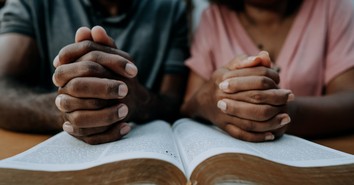The Best Model for Unity and Diversity Is... Christianity!

E Pluribus Unum.
In Latin, it means, "from many, one," and you have likely seen it on the back of a dollar bill. But talking about unity in Latin and actually achieving it in English are clearly two different things. In an age where We The People are increasingly dividing ourselves and creating enemies of one another, Christianity serves as a powerful model of how very different people can became truly united.
We all tend to join groups based on our commonalities with others in the group. Race, income, politics, and various interests are just some things that can unite us or keep us separated. Yet in the early Christian church, believers not only overcame such differences, but used them to their advantage, building a faith that would prove to be stronger and more unifying than any culture or persecution.
It is in Acts 11 that we learn these believers in Jesus were first called 'Christians' in the city of Antioch (Acts 11:26).
Needless to say, the name stuck.
Yet, other than being called Christians, what else did these people have in common? What else held them together?
In Acts 13:1, we are given a list of some of the leaders in this church, and it is fascinating to read just how different these people are:
Now in the church at Antioch there were prophets and teachers: Barnabas, Simeon called Niger, Lucius of Cyrene, Manaen (who had been brought up with Herod the tetrarch) and Saul...
Taking a closer look at the people behind those names, we begin to get a picture of what this church itself looked like, and the beautiful diversity that existed there.
Barnabas: Barnabas had been in Jerusalem before coming to Antioch. He was originally from Cyprus, and was also from the tribe of Levi. Coming from a Levitical family, we can assume Barnabas had a strong Jewish background.
Simeon: We are told that Simeon "was called Niger" (pronounced NYE-jer, or Nee-ZHER, depending who you ask). The word is Latin for the color black, so we can safely know that Simeon was a person of color.
Lucius: We know little about Lucius other than the fact that he was from Cyrene, a city of North Africa in what is modern Libya. The name Lucius, interestingly, means 'bright' or 'light'. It was a very popular Roman name at the time.
Manaen: He was a close associate of Herod the Tetrarch, and actually grew up with Herod. This is the same Herod that sent Jesus back to Pilate before the crucifixion, and ordered John the Baptist beheaded. We can conclude that Manaen was a wealthy man of high standing who spent his weekends hanging out among people of royalty, and considering the actions of his friend Herod, was likely not a very religious type prior to joining the church.
Saul: This is Paul the Apostle who we know so well, here referred to simply as "Saul" (he is not referred to as Paul until later in this same chapter). We know that Saul is from the city of Tarsus, a man well educated in both Greek and Jewish thought, who was formerly a "Pharisee, and a son of a Pharisee." His previous career was to be a proud persecutor of Christians.
The Gospel writer Luke was a physician, and a resident of Antioch. We also know that there were several influential women in early church leadership. Among these are Joanna, wife of Chuza (another person close to Herod's court), Priscilla, who risked her life for the faith along with her husband Aquila, Junia, who suffered imprisonment for their faith, and Phoebe, who personally delivered Paul's Epistle to the Romans.
The picture that emerges is a group of people with strongly varying backgrounds. This is not a homogeneous group of people who are all alike, but rather a very diverse group who probably had little else at all in common outside of Christ.
They were not of the same political background, not the same color, not from the same country, and probably didn't speak the same primary language. Yet they found themselves bound together more tightly than they could be bound to any other cause.
Simply put, they were Christians.
The Jewish Christians found themselves ostracized from their own Jewish communities, at odds with their leaders, their faith, and their nation.
The Roman Christians found themselves ostracized by their own communities, giving up their beliefs and culture in exchange for a belief that God became a Jewish man, was crucified, rose from the dead, and now reigns as the Savior of all mankind. Not a 'mainstream' concept.
For each of these groups, faith in Christ meant a disconnection from and denial of all that they once knew. It meant that all they really had was each other and their faith in Christ.
These who were first called Christians knew what it meant to daily deny themselves and all they once knew as 'normal', take up their cross, and follow Jesus. They knew all too well the pain of persecution, and they knew that by choosing Christ, prison and death could very likely be their end. They were kind to all they encountered, honorable and respected, yet they spoke truth and were ready for whatever consequence that could bring.
They each chose this path willingly and wholeheartedly, which in itself is a testament to the power of their belief. There is no doubt that they believed the of story of Jesus was 100% truth. There is no other explanation for their shift away from all they formerly knew in order to unite with foreigners and strangers in this unpopular faith.
This is the kind of unity that crosses barriers. This is a faith that changes lives, changes empires, and changes the world forever. As we seek our place in society as Christians, let us look to the example given us by those who were the very first Christians, and seek to build unity on a foundation of faith where from many, we truly become One.
As a writer and musician, Jason Soroski strives to communicate in a way that is insightful, meaningful, relevant, and mindful of the small things that we may otherwise overlook in our everyday lives. He effectively taps into his experiences as a worship pastor, classroom teacher, husband, and homeschooling father of five to relate poignant stories from real-life experiences. Jason holds an M.Ed. from Missouri Baptist University, has been featured in various print and web publications, and currently resides in Houston, TX. Read more from Jason at his blog The Way I See It.
Publication date: March 28, 2018
Image Courtesy: Thinkstock/digitalskillet
Originally published March 28, 2018.







